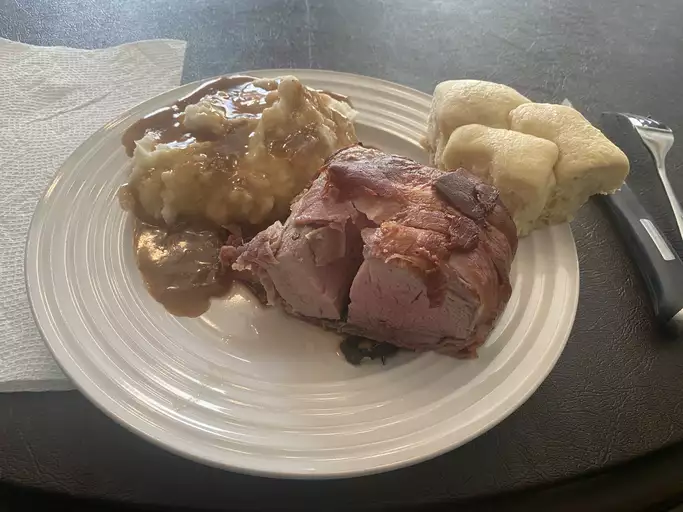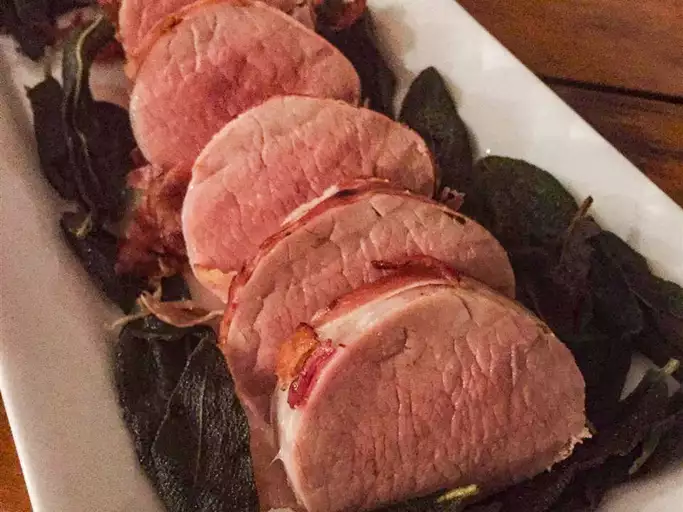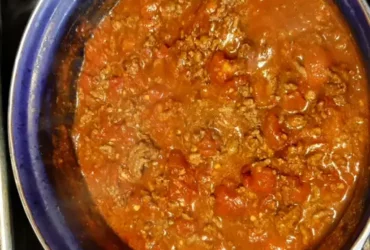Background and History
Prosciutto-wrapped pork tenderloin with crispy sage is a delightful fusion of Italian and classic European culinary traditions. Prosciutto, a dry-cured ham from Italy, brings a salty, savory flavor that perfectly complements the tender, mild pork. Sage, an herb with a long history in European cooking, adds an aromatic and slightly peppery touch. This dish is known for its elegant presentation and the harmony of flavors, making it a popular choice for special occasions and gourmet dinners.

Serves
4
Time
Total: 45 minutes
Cooking Time
25-30 minutes
Ingredients
- 1 pork tenderloin (about 1 to 1.5 pounds)
- 8-10 slices of prosciutto
- 1 tablespoon olive oil
- 12 fresh sage leaves
- 2 cloves garlic, minced
- 1 teaspoon salt
- 1/2 teaspoon black pepper
- 1 tablespoon butter
Instructions
Prepare the Pork Tenderloin:
- Preheat your oven to 375°F (190°C).
- Pat the pork tenderloin dry with paper towels.
- Season the pork with salt and black pepper.
Wrap the Tenderloin
- Lay out the prosciutto slices on a cutting board, slightly overlapping.
- Place the pork tenderloin on top of the prosciutto.
- Spread the minced garlic over the pork.
- Lay 8 sage leaves on top of the pork.
- Carefully wrap the prosciutto around the pork tenderloin, securing it in place.
Sear the Tenderloin
- In an oven-safe skillet, heat the olive oil over medium-high heat.
- Add the prosciutto-wrapped pork tenderloin and sear for 2-3 minutes on each side until the prosciutto is crisp.
Roast the Tenderloin
- Transfer the skillet to the preheated oven.
- Roast for 20-25 minutes, or until the internal temperature reaches 145°F (63°C).
Crisp the Sage
- In a small skillet, melt the butter over medium heat.
- Add the remaining 4 sage leaves and cook until crispy, about 1-2 minutes.
Rest and Serve
- Remove the pork tenderloin from the oven and let it rest for 5-10 minutes.
- Slice the pork into medallions and garnish with the crispy sage leaves.
- Serve with your favorite sides, such as roasted vegetables or mashed potatoes.
Nutrition Facts (per serving)
- Calories: 310
- Protein: 30g
- Fat: 18g
- Carbohydrates: 1g
- Fiber: 0g
- Sugar: 0g
- Sodium: 950mg
Notes
- For a lower sodium option, use reduced-sodium prosciutto or fewer slices.
- Ensure the internal temperature of the pork reaches 145°F (63°C) for safe consumption.
- Letting the meat rest after roasting helps retain its juices and enhances flavor.
Allergy Warning
- This recipe contains dairy (butter).
- Ensure there are no cross-contaminants if serving someone with food allergies.
- Always check the labels of the ingredients for potential allergens.
Why is pork tenderloin so good?
Pork tenderloin is so good because it is a lean cut of meat that is exceptionally tender and has a mild flavor, making it versatile for various seasonings and cooking methods.
How do you cook a pork tenderloin without drying out?
To cook pork tenderloin without drying out, avoid overcooking it by ensuring the internal temperature reaches 145°F (63°C) and allow it to rest for a few minutes after cooking to retain its juices.
Does pork tenderloin need to be seared before baking?
Searing pork tenderloin before baking enhances its flavor by creating a caramelized crust and helps seal in the juices, resulting in a more flavorful and moist dish.
Why is my pork tenderloin tough?
Pork tenderloin can become tough if it is overcooked or cooked at too high a temperature, which causes the proteins to tighten and dry out the meat.
Should pork tenderloin be cooked fast or slow?
Pork tenderloin should be cooked relatively fast at a moderate to high temperature to ensure it remains tender and juicy, typically in the oven or by pan-searing and then roasting.
What is the best way to tenderize pork tenderloin?
The best way to tenderize pork tenderloin is to marinate it for a few hours in an acidic marinade (such as one with lemon juice or vinegar) and to avoid overcooking it.
Is pork tenderloin really tender?
Yes, pork tenderloin is one of the most tender cuts of pork because it comes from a muscle that doesn’t do much work, resulting in a naturally soft texture.
How to tenderize pork tenderloin after cooking?
If a pork tenderloin is tough after cooking, slicing it thinly against the grain can help make it more tender. Additionally, serving it with a sauce or gravy can add moisture.
What is the secret to tender pork loin?
The secret to tender pork loin is to cook it to the correct internal temperature of 145°F (63°C) and to allow it to rest after cooking, which helps the juices redistribute throughout the meat.
Is there a difference between pork loin and pork tenderloin?
Yes, there is a difference between pork loin and pork tenderloin. Pork loin is a larger, wider cut that comes from the back of the pig and is less tender but more versatile, while pork tenderloin is a smaller, more tender cut from the muscle that runs along the backbone.
- Best Lusha Alternatives for 2025 - April 22, 2025
- Best Overloop Alternatives for 2025 - April 22, 2025
- Best 6sense Alternatives for 2025 - April 22, 2025














